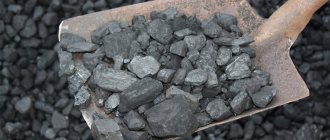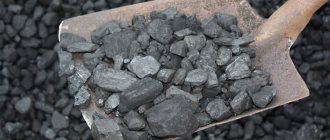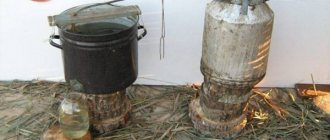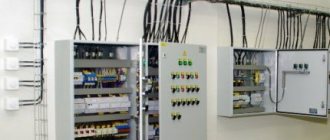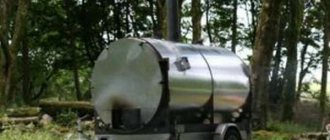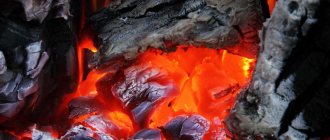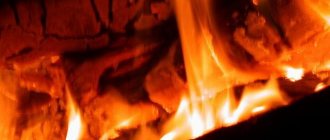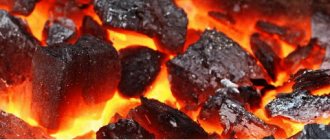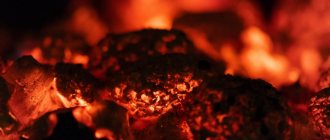Spring has arrived, and with it the time for barbecue. But what do you need to cook a delicious meal in the fresh air?! Of course products! But you can’t do without fuel for a fire, because the aromatic smell of smoke is 50% of success. You can take fruit firewood or any other wood left over from last season. But it is best to use charcoal. Its consumption is low and the heat is stable. Nowadays a huge amount of such raw materials is sold, but we are thrifty owners, aren’t we?! Therefore, I decided to write about how to make charcoal with your own hands at home.
How is charcoal made?
Our ancestors made charcoal. They came to this process purely intuitively. The bottom line is that the wood must burn without oxygen. In the modern world, this procedure is called pyrolysis, and it is used not only in the production of charcoal.
- Making such fuel at home is quite simple. All you need is wood. In fact, any will do, but I do not recommend using resin-containing rocks. They will also make charcoal, but some nuances will need to be taken into account.
- I advise you to use alder, poplar, acacia, oak, beech, hornbeam, maple, ash and even willow. If we approach it from a scientific point of view, then these tree species form different grades of charcoal, which differ in their characteristics. But you and I make fuel for ourselves, at home, so any wood will do. There are three ways to make your own charcoal at home.
Production technology
The production of charcoal consists of a number of sequential operations:
- Drying raw materials.
Despite the fact that dried wood can be used in the production of charcoal, it is necessary to remove residual moisture from the material, which, one way or another, is present in the base raw material. So, immediately after reducing the size of the base raw material, it is subjected to a drying process. In order to effectively dry the raw material, it is placed in a special container that is specifically designed for coal, then the raw material is processed using hot smoke. To reduce costs, the drying container is placed as close as possible to the pyrolysis oven, which produces the necessary heat.
- Pyrolysis process.
Processing of raw materials at this stage involves heating it to a certain temperature. Pyrolysis assumes that the process takes place without access to air, while the raw materials are processed at high temperatures to form coals, and fire is excluded.
- Calcination.
During calcination, the temperature rises to more than 400 degrees; the process allows you to completely eliminate resin and gases from the raw material.
- Cooling of raw materials.
This is the last step in making charcoal and involves gradually cooling the raw material.
Upon completion of the cooling process, the raw materials are packaged and moved to the warehouse. The described technological operations make it possible to produce high-quality products, which for supply to the market can simply be packaged in paper containers of various sizes.
The production technology, despite its simplicity, requires strict adherence to safety precautions and fire safety measures. Be sure to install a fire alarm and have the required number of fire extinguishers on hand to ensure safety; these measures will allow you to quickly localize it in the event of a fire.
The most suitable material for the production of charcoal is wood in lumps up to 60 cm in size. When purchasing solid log material, there is a need for an additional worker, whose task will be to grind the material to the required size.
Charcoal can be produced both on an industrial scale and at home.
Making at home
It is necessary to understand that home production is an excellent solution if a small amount of raw materials is needed. This environmentally friendly fuel is great for small blacksmith shops, cooking shish kebab and barbecue; purchasing raw materials for these purposes costs a pretty penny. Charcoal kilns for the production of charcoal, used in mass production, have large dimensions and a high price - they are not suitable for home use. In practice, the following methods are widely used:
- burning in a metal barrel;
- burning wood in a pit.
Using a metal barrel stove
Let us examine in detail how charcoal is produced using a metal barrel. The barrel must be made of thick metal. It is unacceptable to use containers containing chemicals. If oil-containing products were previously stored in a barrel, the container must be treated.
Temperature-resistant bricks are placed at the bottom of the container, in the space between the bricks, and a fire is placed until the coal is at the height of the bricks. After this, it is necessary to install the grate, and wood material is tightly laid on its surface.
Fill the barrel, wait for the flame to appear. Cover the container with a thick sheet of metal, leaving a small gap.
To speed up the process, you need to make a small hole in the bottom of the container; air can then be supplied through it using a vacuum cleaner. But this part is not particularly important for the overall process.
Control the color of the smoke coming out. After it turns gray, the gap at the top must be eliminated. Next, the container is left until completely cooled, after which the resulting raw materials are sifted and packaged.
Burning out in the pit
The ancient technology of producing charcoal using a pit is discussed in detail below. The advantages of this method include its simplicity and the absence of additional costs for the production of raw materials. It is necessary and sufficient to prepare the wood material and dig a hole in the shape of a cylinder.
The vertical sides of the pit must be made vertical, the radius of the pit is 40 cm, the depth is up to 50 cm. The lower part of the pit must be thoroughly compacted, this will prevent mixing of the soil and the finished raw materials.
A fire is lit directly in the pit; it is important not to use chemicals. After the bottom of the pit is completely filled, pre-prepared wood material (cleared of bark and sawn into pieces up to 30 cm) is placed in it.
When the laid wood burns out, it is necessary to replenish it with a new portion, repeat the laying until the pit is completely filled with coal. This method takes about 3 hours.
The completely filled hole is covered with grass and earth and compacted. Allow the raw materials to cool for 48 hours, after which the finished coals are sifted and packaged. From one pit, up to 2 bags of raw materials come out. The quality of raw materials depends on compliance with all the nuances of the technological process, but the type of wood chosen to obtain raw materials has a greater influence.
Industrial production
Industrial production of charcoal occurs today using two technologies, which require different equipment:
- burning wood material using continuous cycle kilns;
- burning wood using cyclic kilns.
What equipment to use depends on:
- method of organizing the firing process of the initial product;
- what type of wood is used to obtain the finished product.
Not so long ago, there was an acute shortage of equipment for the production of charcoal on the domestic market. There were two main directions: affordable Chinese-made stoves, which entrepreneurs avoided due to dubious quality; much more expensive analogues from European countries - entrepreneurs simply could not afford to purchase such equipment.
Today there is a way out of the situation - equipment from a domestic manufacturer; in terms of cost and quality, the product is well suited for the Russian consumer. Thus, the issue of purchasing high-quality and affordable equipment is resolved simply. However, the issue of complex organization of profitable industrial production of charcoal is a more complex task.
When producing charcoal, fire safety regulations must be observed.
Charcoal in a pit
The easiest way to make charcoal at home is to make it in a pit. To do this you will need firewood, a metal sheet meter by meter or some other metal cover. And of course the pit itself. I recommend digging it up to a meter deep and 60-80 centimeters wide. From this volume you will get almost two bags of charcoal.
- The first step is to dig a hole and compact the bottom well.
- Next, we begin to build a fire at the bottom of the pit. Any firewood and sticks are suitable for this.
- It is worth filling the hole about a third. When the wood is almost burnt out, put the rest of the wood on top to the top. It will be very good if all the logs are the same size. They must be folded very carefully (if possible). As I wrote earlier, in principle you can use any wood. But it is better to take a certain type of wood for one firebox.
- When all the piled firewood has caught fire and the fire appears from above, you need to cover the fire with a lid or a sheet of iron. Next, sprinkle everything with soil to block the access of oxygen to the maximum. You can also sprinkle raw grass on top. The most important thing is that the lid is flush with the ground and does not rest against the firewood.
- Next, we leave our pit alone for a couple of days until the process is completed and the firewood itself has cooled down. After this time, remove the lid and take out the charcoal you made yourself.
A few words about the idea
It is difficult to find people all over the world who would not love outdoor recreation with barbecue or kebabs. This is exactly the place for charcoal, which can work real miracles in the process of making dishes. As we understand, there will always be a demand for such a product, so the payback will be quick. And the production costs of such a product will require a minimum.
The essence of making charcoal is the special pyrolysis of wood at temperatures reaching 700 degrees. As a result of this process, a porous, environmentally friendly substance is obtained. Birch bark is used as a raw material for this product.
Not only individual residents who love outdoor recreation are interested in purchasing such a product, but also baths, cafes, restaurants and various health centers. But let’s look at a clear business plan step by step.
In a barrel
A more optimal way, in my opinion, to make charcoal at home is to produce it in a metal barrel. It can be of any size. If you have a container made of petroleum products or other materials, I recommend that you burn it thoroughly before use. There are two ways to make charcoal in a barrel.
- The first method resembles the process of making charcoal in a pit. The only exception would be that there is no need to dig a hole. I recommend placing two bricks at the bottom of the barrel and building a fire between them. When the fire is strong enough, place a metal grate on top of the bricks. After that, place the firewood on it. When the fire has consumed the entire top layer, close the barrel with a lid, leaving a small gap. After a while, white smoke should come out of it, this is a sign that the lid can be closed completely. Next, we wait until the barrel cools down and take out our fuel.
- The second method involves making a fire under the barrel itself. Firewood is loaded inside the container, the lid is closed, and a small hole is made at the bottom for air to enter and gases to escape. The barrel needs to be placed on some kind of frame - these can be ordinary bricks. Next, make a fire and maintain the fire for 12 hours. This time may vary depending on the type of wood. After this period, you can open the barrel and take out the coal. This method is good because the finished coals are of the correct shape and do not crumble so much. The downside is that the process takes a lot of time.
Properties of charcoal
Charcoal is a solid, porous, high-carbon raw material. Charcoal is produced from wood material by heating in the absence of oxygen (possibly with a small amount of it); retorts, ovens, and heaps are used for this. The raw material mainly consists of carbon, which shares its properties with coal.
Both of these substances are obtained from wood. Only in the case of coal, the starting material is wood of natural origin, which decomposes in the absence of air over several centuries . Coal is produced by partially burning wood with limited air access. Such raw materials are recognized as one of the best types of fuel; they are environmentally friendly; the smoke released during combustion does not have a harmful effect on the environment.
The raw material has high porosity, which explains its good sorption properties. This allows for the purification of water, gases, and alcohol. It is important that the chemical and physical properties of the raw material can cause it to spontaneously ignite (it actively interacts with oxygen). The substance has high thermal conductivity, which is significantly affected by humidity and temperature; it is almost the same as that of coal.
High-quality raw materials after the end of the production cycle have a clear shine with a bluish tint. When crumbling such a product, you can notice that the wood structure is preserved, the raw material is riddled with cracks.
The yield when processing dry wood material will be up to 40% of the original mass.
There are special criteria for assessing the quality of charcoal
In the oven
- You can cook charcoal in any oven. To do this, we light a fire, add wood, and wait for it to burn. It is necessary to wait until they turn completely red, after which they must be removed from the oven and transferred to a metal or ceramic container.
- After this, you need to immediately close it with a lid, blocking the access of oxygen. When the container has cooled down, it can be removed from the container.
- I’ll be honest, I haven’t tried this method, and it seems to me that the charcoal that comes out isn’t of very good quality. But if you don't want to dig a hole or don't have a barrel, you can use it.
Bottom line
I hope my article today was clear and useful to you. Now you know that you can not only buy charcoal, but also make it yourself. I'm confident you'll succeed and enjoy delicious outdoor meals cooked with home-grown fuel.
If you are not yet familiar with my colleague’s article “Spring, it’s time for barbecue, or how to make a fire correctly,” then you can read it at this link.
Write in the comments what you use for the fire: wood or charcoal?
How to organize your own coal production business
As already mentioned, organizing a charcoal production business is simple, and anyone can do it.
Production technology
The charcoal production technology consists of 4 main stages:
- Drying raw materials. It consists of drying the starting material for better smoldering in the oven. The process occurs when raw materials are placed in a furnace and treated with smoke at a temperature of 130 to 160 ° C. With this treatment, wood loses up to 95% of its moisture content.
- Pyrolysis is the burning of wood in a closed retort-type furnace (that is, heated from the outside, without access to oxygen, or with a limited supply of oxygen). The temperature after drying the raw material increases to 300° C, the raw material completely loses moisture and becomes charred.
- Calcination, turning charred wood into coal, and separating resins and gases from it. Occurs at temperatures from 300 to 400° C. The most optimal temperature is considered to be 350-380° C.
- Coal cooling.
After cooling, the finished coal, if necessary, is crushed into smaller fractions and packaged in bags or bags.
The degree of wood combustion and flame temperature are regulated by special sensors installed in the equipment. At home, the best results are achieved experimentally.
The production of charcoal in retort ovens by pyrolysis is shown in the video below.
Making charcoal at home
Making charcoal at home is not much different from the industrial process. The differences lie in the equipment used and the feedstock requirements. To produce coal using the artisanal method, it is necessary to use only solid wood - firewood, logs, large branches, etc.
As equipment, you can use a regular metal barrel with a capacity of 200 liters or more. It is necessary to drill holes in the upper part of the barrel to allow the accumulated gases to escape. The barrel is tightly closed with a lid, placed over the fire and heated to a temperature of 350-380 ° C. When the specified temperature is reached, the barrel should remain above the flame for another 2-2.5 hours, after which it is removed from the heat. The lid opens only after it has completely cooled down.
Instead of a barrel, you can also use an ordinary hole dug in the ground. The lid can be a simple metal sheet. The process of obtaining coal can be seen in the video:

